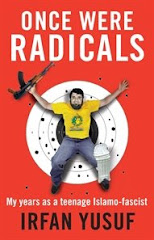Anyway, I recently came across the handwritten notes to the "paper" I did. Nothing special. The heading on the notes is as follows: "From Ethno-Religious Communities to Faith-Community - Australian Muslim Migrants and Cultural Integration".
I've typed up the notes as they appeared on the rough notes.
[01] Islam in modern Australia is largely a migrant phenomenon. It consists of various ethnic groups for whom religious faith is often largely incidental and coincidental of ethnic identity.
[02] Multiculturalism as government policy emphasised ethnic and linguistic features. Largely locked out of the Muslim discourse were indigenous people of Muslim heritage, European converts and the 2nd and 3rd generation offspring of migrants. They were also locked out from Muslim religious affairs and from being the public face of Islam.
[03] The Howard government [this paper was delivered just before the 2007 election] has moved toward focusing on citizenship and integration. The goal has been restoring the hegemony of an allegedly "Judeo-Christian" heritage at the expense of belief systems deemed insufficiently European. This includes Islam.
[04] But in the case of Islam, this may have the opposite effect, especially as younger Muslims look to religious scholarship in North America and Europe for guidance. (A related phenomenon is the impact of of Muslimphobia creating a sense of united victimhood.)
[05] How do we define "community"? What are the building blocks of a community? Why aren't Australian Muslims a single community? What features do they lack?
* They have no single structure recognised by all or most as an institutional authority.
* They have no single language of liturgy (other than the nominal use of Arabic in formal prayers).
* They have no central clerical authority.
*They have numerous competing layers of identity.
[06] What is the reality of Australian Islam?
* Mosque management is divided along ethnic and linguistic lines.
* There is a high degree of jurisprudential pluralism with 4 Sunni schools of law, Ithna Ashariyya, numerous Shia offshoots and a variety of salafi/wahhabi branches.
* Limited ability to reach consensus on even basic things e.g. the start and end of lunar months leading to key festivals being held on different days.
[07] Why is it difficult to talk about this subject?
* So little empirical evidence.
* Much research funded by governments, with funds often received by groups with sectarian axes to grind.
[08] The paper was partially an attempt at predicting how institutions will be built. The "war on terror" has created a tension between neo-liberal governments imposing from above, as opposed to spontaneous institution-building in the sense advanced by F Hayek.
And there endeth the lesson!











